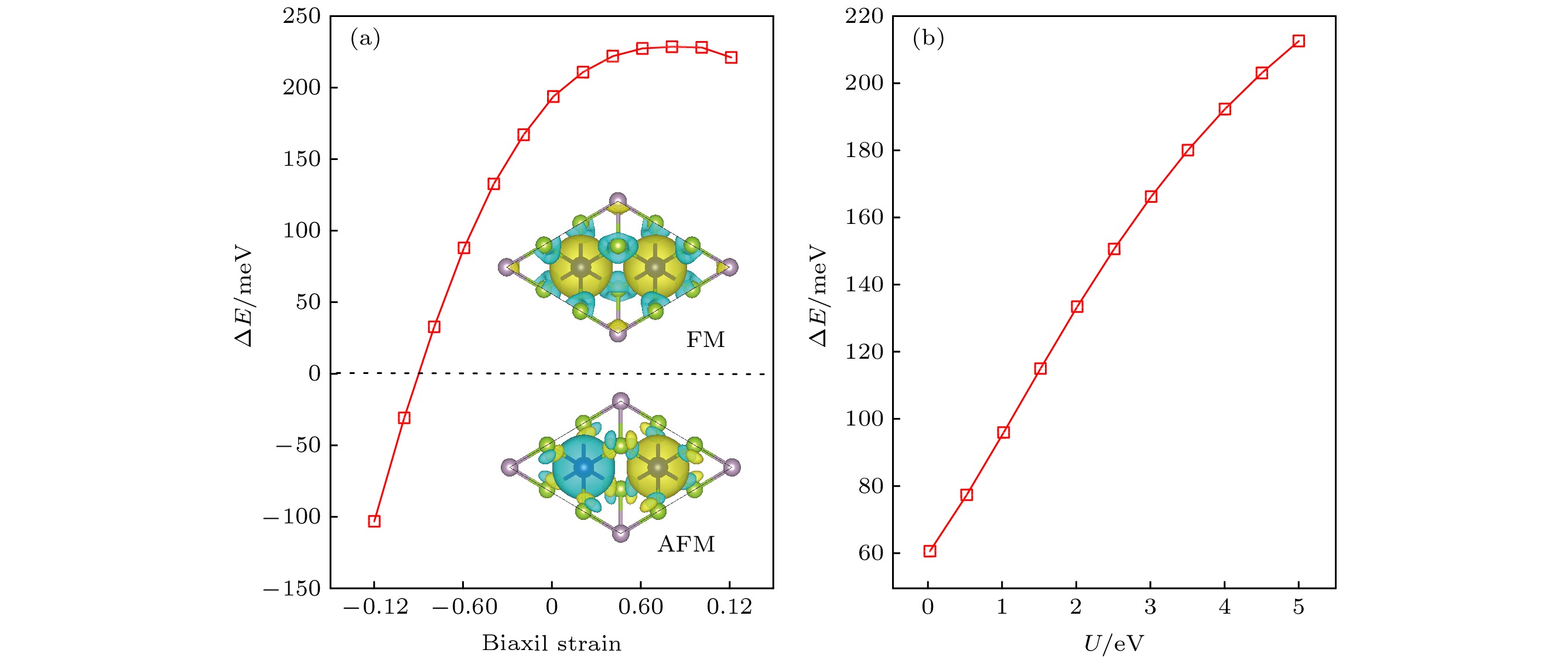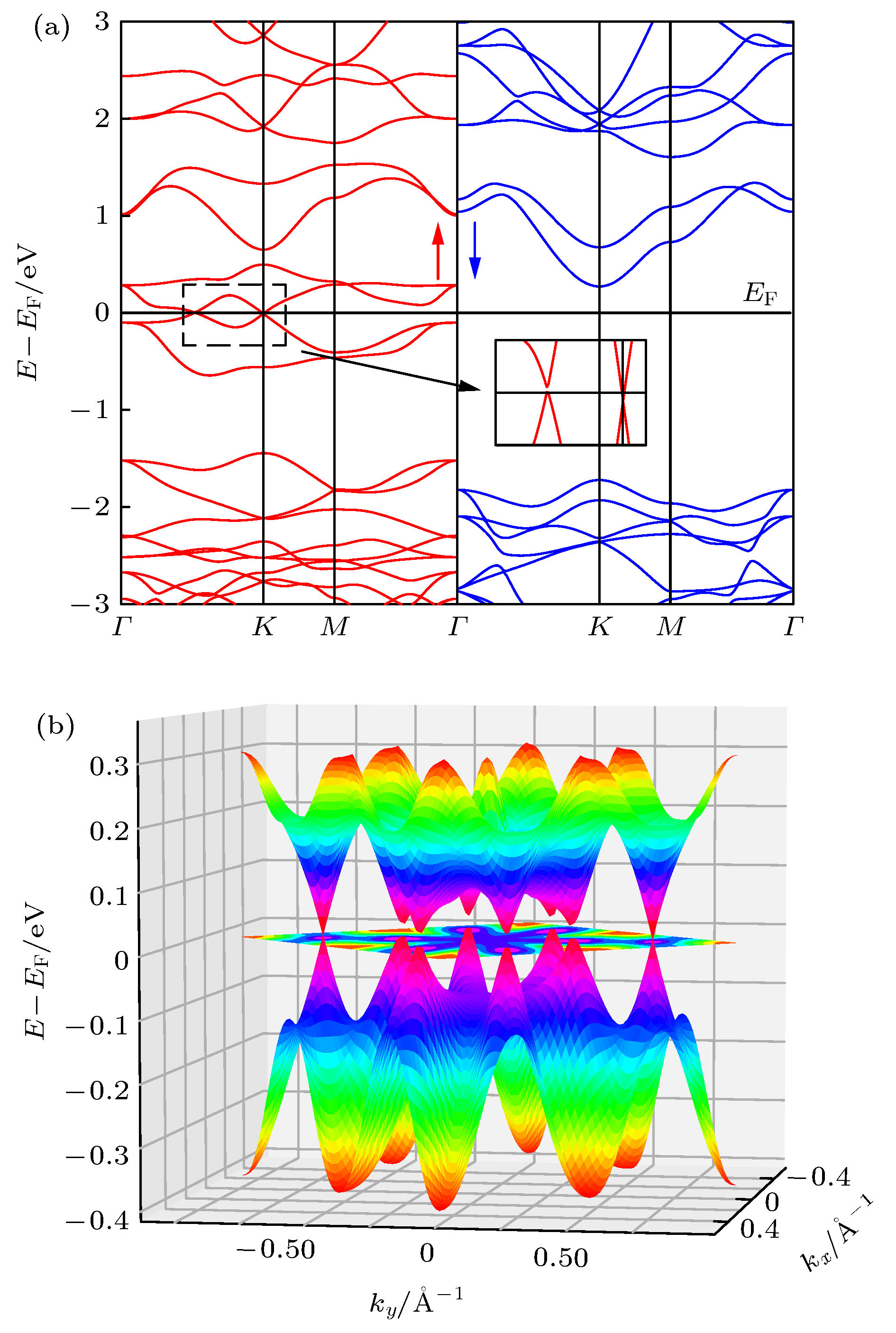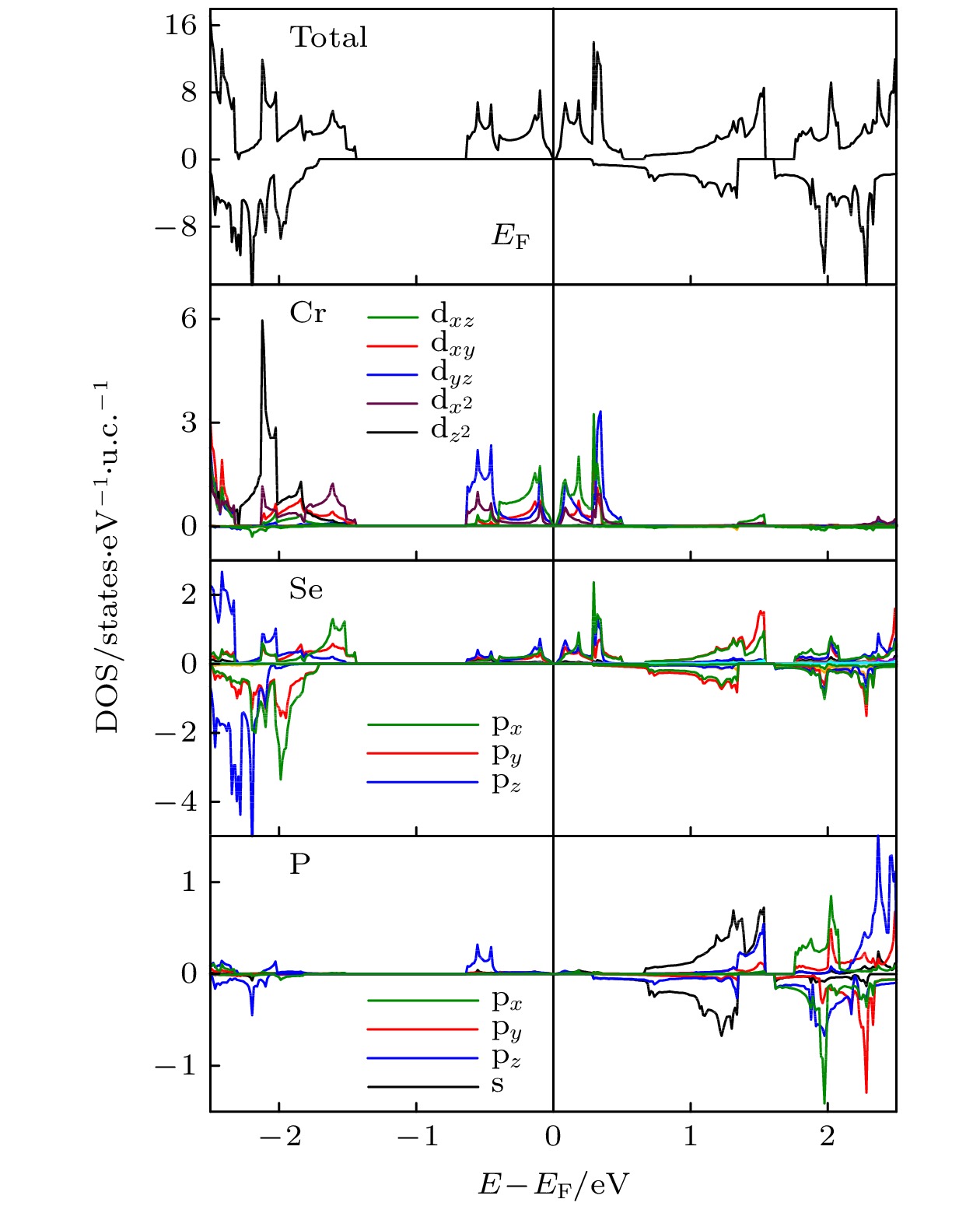-
采用第一性原理方法和紧束缚模型研究了二维层状结构过渡金属硫族磷化物CrPSe3的磁学特性和电子结构. 二维CrPSe3晶格呈现六角蜂窝状结构, 声子谱证明其具备较好的动力学稳定性. 二维CrPSe3的电子结构呈现出自旋无能隙磁性半金属特性. 蒙特卡罗方法模拟出二维CrPSe3的居里温度为224 K, 分子动力学表明其具有良好的热力学稳定性. 晶体和电子结构研究揭示二维CrPSe3的磁性来源于反铁磁性的d-d直接交换作用和铁磁性的p-d超交换作用间的相互竞争. 二维CrPSe3的自旋向上的能带展现出奇异特性: 除了高对称点K处出现的一类狄拉克锥之外, 在高对称路径
$ \varGamma $ -K的中点附近也出现了一类狄拉克锥结构, 二者均有较高的费米速度. 电子结构表明狄拉克电子主要源于Cr$ {\rm{d}}_{xz} $ 和$ {\rm{d}}_{yz} $ 轨道的贡献. 在电子结构分析的基础上, 采用紧束缚模型对二维CrPSe3费米能级附近的能带进行模拟, 结果证明二维CrPSe3的多狄拉克锥结构受过渡金属Cr的六角几何排列对称性保护. 该研究为揭示二维材料的磁性机理和研制高温高速自旋器件提供了一良好的模型平台.According to the first-principles calculation within PBE+U method and tight-binding model, the magnetic properties and electronic structures of two-dimensional (2D) CrPSe3 monolayer were investigated. Constructed by a Cr-honeycomb hexagonal lattice, 2D CrPSe3 was predicted to be in a half-metallic ferromagnetic state with dynamic stability, confirmed by the phonon spectrum with no imaginary dispersion. The Curie temperature was estimated as 224 K by Monte Carlo simulation within the Metropolis algorithm under the periodic boundary condition. The thermal stability of CrPSe3 monolayer was estimated at 300 K by a first-principles molecular dynamics simulation. It is found that the magnetic ground state of CrPSe3 monolayer is determined by a competition between the antiferomagnetic d-d direct exchange interactions and the Se-p orbitals mediated ferromagnetic p-d superexchange interactions. Most interestingly, in the half-metallic state the band structure exhibits multiple Dirac cones in the first Brillouin zone: two cones at K point showing a very high Fermi velocity${v_{\rm F}{(K)}} = 15.8 \times 10^5 \;{\rm m \!\cdot\! s^{-1}}$ about twice larger than the$ v_{\rm F} $ of graphene in the vicinity of Fermi level, and six cones at$ K'/2 $ points with${ v_{\rm F} {(K'/2)}} = 10.1 \times 10^5\;{\rm m \!\cdot\! s^{-1}}$ close to the graphene's value. These spin-polarized Dirac cones are mostly composed of Cr${\rm d}_{xz}$ and${\rm d}_{yz}$ orbitals. The novel electronic structure of CrPSe3 monolayer is also confirmed by the HSE06 functional. A tight-binding model was built based on the Cr-honeycomb structure with two Cr-d orbitals as the basic with the first, second and third nearest-neighboring interactions, further demonstrating that the multiple Dirac cones are protected by the Cr-honeycomb lattice symmetry. Our findings indicate that 2D CrPSe3 monolayer is a candidate with potential applications in the low-dimensional, high speed and temperature spintronics.-
Keywords:
- two-dimensional ferromagnetism /
- Dirac cone /
- first-principles calculation /
- tight-binding method
[1] Novoselov K S, Geim A K, Morozov S V, Jiang D, Zhang Y, Dubonos S V, Grigorieva I V, Firsov A A 2004 Science 306 666
 Google Scholar
Google Scholar
[2] 王兴悦, 张辉, 阮子林, 郝振亮, 杨孝天, 蔡金明, 卢建臣 2020 物理学报 69 118101
Wang X Y, Zhang H, Ruan Z L, Hao Z L, Yang X T, Cai J M, Lu J C 2020 Acta Phys. Sin. 69 118101
[3] Li L, Yu Y, Ye G J, Ge Q, Ou X, Wu H, Feng D, Chen X H, Zhang Y 2014 Nat. Nanotechnol. 9 372
 Google Scholar
Google Scholar
[4] Watanabe K, Taniguchi T, Kanda H 2004 Nat. Mater. 3 404
 Google Scholar
Google Scholar
[5] Han G H, Duong D L, Keum D H, Yun Se J, Lee Y H 2018 Chem. Rev. 118 6297
 Google Scholar
Google Scholar
[6] Burch K S, Mandrus D, Park J 2018 Nature 563 47
 Google Scholar
Google Scholar
[7] S Babar, Nadeem M, Dai Z, Fuhrer M S, Xue Q, Wang X, Bao Q 2018 Appl. Phys. Rev. 5 041105
 Google Scholar
Google Scholar
[8] Huang B, Clark G, Navarro-Moratalla E, Klein D R, Cheng R, Seyler K L, Zhong D, Schmidgall E, McGuire M A, Cobden D H, Yao W, Xiao D, Jarillo-Herrero P, Xu X 2017 Nature 546 270
 Google Scholar
Google Scholar
[9] 邓雨君, 於逸骏, 张远波 2019 物理 2 88
 Google Scholar
Google Scholar
Deng Y J, Yu Y J, Zhang Y B 2019 Physics 2 88
 Google Scholar
Google Scholar
[10] Gong C, Li L, Li Z, Ji H, Stern A, Xia Y, et al. 2017 Nature 546 265
 Google Scholar
Google Scholar
[11] Wang F, Shifa T A, Yu P, He P, Liu Y, et al. 2018 Adv. Funct. Mater. 28 1802151
 Google Scholar
Google Scholar
[12] 俞强, 郭琨, 张颖聪, 陈捷, 王涛, 汪进, 史鑫尧, 吴坚, 张凯, 周朴 2020 物理学报 69 184208
 Google Scholar
Google Scholar
Yu Q, Guo K, Zhang Y C, Chen J, Wang T, Wang J, Shi X Y, Wu J, Zhang K, Zhou P 2020 Acta Phys. Sin. 69 184208
 Google Scholar
Google Scholar
[13] 龚吉祥, 严秀, 杨军, 葛敏, 皮雳, 朱文卡, 张昌锦 2018 低温物理学报 40 22
 Google Scholar
Google Scholar
Gong J X, Yan X, Yang J, Ge M, Pi L, Zhu W K, Zhang C J 2018 Chin. J. Low Temp. Phys. 40 22
 Google Scholar
Google Scholar
[14] Sivadas N, Daniels M W, Swendsen R H, Okamoto S, Xiao D 2015 Phys. Rev. B 91 235425
 Google Scholar
Google Scholar
[15] Chittari B L, Park Y, Lee, Han D M, MacDonald A H, Hwang E, Jung J 2016 Phys. Rev. B 94 184428
 Google Scholar
Google Scholar
[16] Kim S Y, Kim T Y, Sandilands L J, Sinn S, Lee M C, et al. 2018 Phys. Rev. Lett. 120 136402
 Google Scholar
Google Scholar
[17] Li X, Cao T, Niu Q, Shi J, Feng J 2013 Proc. Natl. Acad. Sci. U.S.A. 110 3738
 Google Scholar
Google Scholar
[18] Pei Q, Wang X, Zou J, Mi W 2018 J. Mater. Chem. C 6 8092
 Google Scholar
Google Scholar
[19] Gu Y, Zhang Q, Le C, Li Y, Xiang T, Hu J 2019 Phys. Rev. B 100 165405
 Google Scholar
Google Scholar
[20] Sugita Y, Miyake T, Motome Y 2018 Phys. Rev. B 197 035125
[21] Gusmão R, Sofer Z, Sedmidubský D, Huber Š, Martin P 2017 ACS Catal. 7 8159
 Google Scholar
Google Scholar
[22] Kresse G, Hafner J 1994 J. Phys. Condens. Matter 6 8245
 Google Scholar
Google Scholar
[23] Kresse G, Joubert D 1999 Phys. Rev. B 59 1758
[24] Perdew J, Burke K, Ernzerhof M 1996 Phys. Rev. Lett. 77 3865
 Google Scholar
Google Scholar
[25] Dudarev S L, Botton G A, Savrasov S Y, Humphreys C J, Sutton A P 1998 Phys. Rev. B 57 1505
 Google Scholar
Google Scholar
[26] Grimme S 2006 J. Comput. Chem. 27 1787
 Google Scholar
Google Scholar
[27] Blöchl P E, Jepsen O, Andersen O 1994 Phys. Rev. B 49 16223
 Google Scholar
Google Scholar
[28] Chaput L, Togo A, Tanaka I, Hug G 2011 Phys. Rev. B 84 094302
 Google Scholar
Google Scholar
[29] Togo A, Tanaka I 2015 Scr. Mater. 108 1
 Google Scholar
Google Scholar
[30] Metropolis N, Rosenbluth A W, Rosenbluth M N, Teller A H, Teller E 1953 J. Chem. Phys. 21 1087
 Google Scholar
Google Scholar
[31] Pizzi G, Vitale V, Arita R, et al. 2019 J. Phys. Condens. Matter 32 165902
 Google Scholar
Google Scholar
[32] Wang V, Xu N, Liu J C, Tang G, Geng W T 2019 arXiv: 1908.08269
[33] Goodenough J B 1955 Phys. Rev. B 100 564
 Google Scholar
Google Scholar
[34] Kanamori J 1960 J. Appl. Phys. 31 S14
 Google Scholar
Google Scholar
[35] Anderson P W 1959 Phys. Rev. B 115 2
 Google Scholar
Google Scholar
[36] Heyd J, Scuseria G E, Ernzerhof M 2003 J. Chem. Phys. 118 8207
 Google Scholar
Google Scholar
-
图 1 二维CrPSe3的(a) 晶体结构俯视图和侧视图(灰色虚线表示晶体单胞), (b) 声子谱(插图为布里渊区及高对称点)和声子态密度
Fig. 1. (a) Top and side views of two-dimensional (2D) CrPSe3 monolayer with the hexagonal unit cell denoted by grey broken lines; (b) the phonon spectrum and the corresponding density of states (DOS) for Cr, P and Se atoms, respectively, the inset shows the Brillouin zone of 2D CrPSe3 monolayer
图 2 二维CrPSe3的交换作用能
$\Delta E$ (meV) 随(a)面内双轴压力(负值表示压缩, 正值表示膨胀)和(b)$U$ 值的变化曲线, 图(a)内插图是铁磁态和反铁磁态的自旋电荷密度图, 等值面密度为 3 × 10–3${\rm{e}}$ ·Å–3, 淡黄和浅蓝分别代表自旋向上和自旋向下的电荷密度分布Fig. 2. Exchange parameters
$\Delta E=E({\rm{AFM}})-E({\rm{FM}})$ (meV) with respect to (a) in-plane biaxial strain (negative value denotes compressive and postive means tensile) and (b) U value of 2D CrPSe3. The insects of panel (a) is the spin electron density of 2D CrPSe3 in FM and AFM states with isovalue of 3 × 10–3${\rm{e }}$ ·Å–3. The yellow and cyan colors represent spin-up and down electrons, respectively图 3 二维CrPSe3 (a)相对磁矩和比热容相对于温度的蒙特卡罗模拟变化曲线, 以及(b) 300 K温度下
$4\times4\times1$ 超胞总能随时间的变化, 插图是弛豫6 ps 后的晶体结构图Fig. 3. (a) The Monte Carlo simulated magnetic moment and specific heat capacity as a function of temperature and (b) total energy fluctuations with respect to the simulation time at 300 K of CrPSe3 monolayer. The inset shows the corresponding structure at 300 K after the simulation for 6 ps
图 A1 (a) HSE06杂化泛函与PBE + U计算结果比较; (b)几个典型的U值的计算结果; (c) 几个典型的压力值下二维CrPSe3自旋向上和自旋向下的能带图; 费米能级设置为0 eV
Fig. A1. Spin up and spin down band structures along high symmetry
$k$ -points: (a) Calculated by HSE06 functional results compared with that of PBE + U method; (b) calculated by some typical U value; (c) under typical strain effeccts of 2D CrPSe3. Fermi level is set to 0 eV图 6 紧束缚近似模型 (a) 二维CrPSe3轨道跃迁示意图; (b)考虑
$t_1$ ,$t_2$ 和$t_3$ 跃迁系数时二维CrPSe3的紧束缚近似能带图; (c)仅考虑$t_3$ 跃迁系数时二维CrPSe3的紧束缚近似能带图Fig. 6. Tight binding model: (a) Hoping parameters illustration and band structures considered (b) all
$t_1$ ,$t_2$ and$t_3$ hopping parameters and (c) only$t_3$ hopping parameters of 2D CrPSe3 monolayer表 1 二维CrPSe3的优化结果(晶格常数
$a$ (Å)、晶体厚度$h$ (Å)、部分键长$d$ (Å) 和原子间的夹角$\theta\;(^\circ)$ )Table 1. Optimized lattice constants
$a$ (Å), monolayer thickness$h$ (Å), some bond legths$d$ (Å) and angle$\theta\;(^\circ)$ between some atoms of 2D CrPSe3 monolayer晶格常数/Å 键长 d/Å 原子夹角$\theta /(^\circ)$ a 6.364 Cr—Cr 3.674 Cr—Se—Cr 85.3 b 6.364 Cr—Se 2.711 Se—P—Se 113.5 h 3.394 P—Se 2.211 -
[1] Novoselov K S, Geim A K, Morozov S V, Jiang D, Zhang Y, Dubonos S V, Grigorieva I V, Firsov A A 2004 Science 306 666
 Google Scholar
Google Scholar
[2] 王兴悦, 张辉, 阮子林, 郝振亮, 杨孝天, 蔡金明, 卢建臣 2020 物理学报 69 118101
Wang X Y, Zhang H, Ruan Z L, Hao Z L, Yang X T, Cai J M, Lu J C 2020 Acta Phys. Sin. 69 118101
[3] Li L, Yu Y, Ye G J, Ge Q, Ou X, Wu H, Feng D, Chen X H, Zhang Y 2014 Nat. Nanotechnol. 9 372
 Google Scholar
Google Scholar
[4] Watanabe K, Taniguchi T, Kanda H 2004 Nat. Mater. 3 404
 Google Scholar
Google Scholar
[5] Han G H, Duong D L, Keum D H, Yun Se J, Lee Y H 2018 Chem. Rev. 118 6297
 Google Scholar
Google Scholar
[6] Burch K S, Mandrus D, Park J 2018 Nature 563 47
 Google Scholar
Google Scholar
[7] S Babar, Nadeem M, Dai Z, Fuhrer M S, Xue Q, Wang X, Bao Q 2018 Appl. Phys. Rev. 5 041105
 Google Scholar
Google Scholar
[8] Huang B, Clark G, Navarro-Moratalla E, Klein D R, Cheng R, Seyler K L, Zhong D, Schmidgall E, McGuire M A, Cobden D H, Yao W, Xiao D, Jarillo-Herrero P, Xu X 2017 Nature 546 270
 Google Scholar
Google Scholar
[9] 邓雨君, 於逸骏, 张远波 2019 物理 2 88
 Google Scholar
Google Scholar
Deng Y J, Yu Y J, Zhang Y B 2019 Physics 2 88
 Google Scholar
Google Scholar
[10] Gong C, Li L, Li Z, Ji H, Stern A, Xia Y, et al. 2017 Nature 546 265
 Google Scholar
Google Scholar
[11] Wang F, Shifa T A, Yu P, He P, Liu Y, et al. 2018 Adv. Funct. Mater. 28 1802151
 Google Scholar
Google Scholar
[12] 俞强, 郭琨, 张颖聪, 陈捷, 王涛, 汪进, 史鑫尧, 吴坚, 张凯, 周朴 2020 物理学报 69 184208
 Google Scholar
Google Scholar
Yu Q, Guo K, Zhang Y C, Chen J, Wang T, Wang J, Shi X Y, Wu J, Zhang K, Zhou P 2020 Acta Phys. Sin. 69 184208
 Google Scholar
Google Scholar
[13] 龚吉祥, 严秀, 杨军, 葛敏, 皮雳, 朱文卡, 张昌锦 2018 低温物理学报 40 22
 Google Scholar
Google Scholar
Gong J X, Yan X, Yang J, Ge M, Pi L, Zhu W K, Zhang C J 2018 Chin. J. Low Temp. Phys. 40 22
 Google Scholar
Google Scholar
[14] Sivadas N, Daniels M W, Swendsen R H, Okamoto S, Xiao D 2015 Phys. Rev. B 91 235425
 Google Scholar
Google Scholar
[15] Chittari B L, Park Y, Lee, Han D M, MacDonald A H, Hwang E, Jung J 2016 Phys. Rev. B 94 184428
 Google Scholar
Google Scholar
[16] Kim S Y, Kim T Y, Sandilands L J, Sinn S, Lee M C, et al. 2018 Phys. Rev. Lett. 120 136402
 Google Scholar
Google Scholar
[17] Li X, Cao T, Niu Q, Shi J, Feng J 2013 Proc. Natl. Acad. Sci. U.S.A. 110 3738
 Google Scholar
Google Scholar
[18] Pei Q, Wang X, Zou J, Mi W 2018 J. Mater. Chem. C 6 8092
 Google Scholar
Google Scholar
[19] Gu Y, Zhang Q, Le C, Li Y, Xiang T, Hu J 2019 Phys. Rev. B 100 165405
 Google Scholar
Google Scholar
[20] Sugita Y, Miyake T, Motome Y 2018 Phys. Rev. B 197 035125
[21] Gusmão R, Sofer Z, Sedmidubský D, Huber Š, Martin P 2017 ACS Catal. 7 8159
 Google Scholar
Google Scholar
[22] Kresse G, Hafner J 1994 J. Phys. Condens. Matter 6 8245
 Google Scholar
Google Scholar
[23] Kresse G, Joubert D 1999 Phys. Rev. B 59 1758
[24] Perdew J, Burke K, Ernzerhof M 1996 Phys. Rev. Lett. 77 3865
 Google Scholar
Google Scholar
[25] Dudarev S L, Botton G A, Savrasov S Y, Humphreys C J, Sutton A P 1998 Phys. Rev. B 57 1505
 Google Scholar
Google Scholar
[26] Grimme S 2006 J. Comput. Chem. 27 1787
 Google Scholar
Google Scholar
[27] Blöchl P E, Jepsen O, Andersen O 1994 Phys. Rev. B 49 16223
 Google Scholar
Google Scholar
[28] Chaput L, Togo A, Tanaka I, Hug G 2011 Phys. Rev. B 84 094302
 Google Scholar
Google Scholar
[29] Togo A, Tanaka I 2015 Scr. Mater. 108 1
 Google Scholar
Google Scholar
[30] Metropolis N, Rosenbluth A W, Rosenbluth M N, Teller A H, Teller E 1953 J. Chem. Phys. 21 1087
 Google Scholar
Google Scholar
[31] Pizzi G, Vitale V, Arita R, et al. 2019 J. Phys. Condens. Matter 32 165902
 Google Scholar
Google Scholar
[32] Wang V, Xu N, Liu J C, Tang G, Geng W T 2019 arXiv: 1908.08269
[33] Goodenough J B 1955 Phys. Rev. B 100 564
 Google Scholar
Google Scholar
[34] Kanamori J 1960 J. Appl. Phys. 31 S14
 Google Scholar
Google Scholar
[35] Anderson P W 1959 Phys. Rev. B 115 2
 Google Scholar
Google Scholar
[36] Heyd J, Scuseria G E, Ernzerhof M 2003 J. Chem. Phys. 118 8207
 Google Scholar
Google Scholar
计量
- 文章访问数: 8871
- PDF下载量: 289
- 被引次数: 0























 下载:
下载:






























